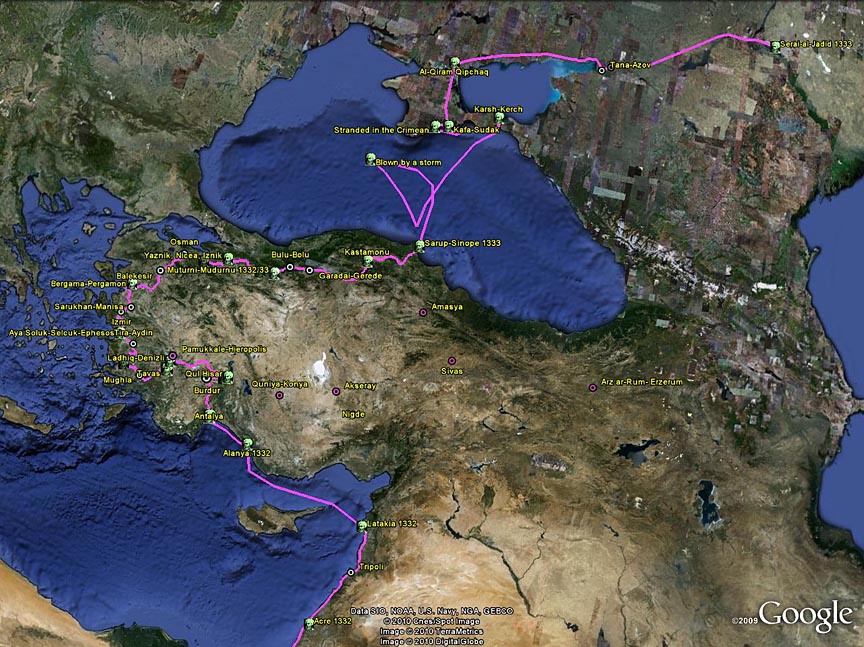‘Aydhab
Aidhab (also Aydhab; Arab عيذاب, DMG ʿ Aiḏāb ) was a port city on the Red Sea in the Middle Ages.
Location
The place was located east of Aswan, in today's Egyptian- Sudanese border, 20 kilometers north of the present village Halaib, located in the disputed area of Hala'ib Triangle. The outlines of the city are living through satellite images fairly well known, remains of port facilities can not be seen in these pictures. The settlement consisted of about 1.5 square kilometers between low hills on the Coral Coast. A district with houses made of coral near the port could be distinguished from an urban area with simpler houses of sedentary nomads. The stone buildings surrounding courtyards, as well as in the other port locations Badi and Dhalak Kebir. The cemeteries in the north and south of the village were greater than it would have been the local demand can be expected.
History
For the 5th century is detectable for Aidhab or a few kilometers northern old port Berenike a Bishop Nabis in literary sources. Thus, Christianity would have here a century earlier than in the interior Nubia foothold. In the Middle Ages Aidhab, thanks to its convenient location across from Jeddah, one of the main ports for African pilgrims on their way to Mecca. Another harbor was something further south Badi, was its heyday between the mid-7th and the mid-12th century. Aidhab was the end point of a caravan route and served as a port for trade with Yemen, India and the Far East. The small town witnessed in the second half of the 11th century a boom, the land routes were always uncertain than by the Crusaders to Mecca and these had occupied the Sinai. Export goods were cotton, dates, sugar and glass. Spices, pearls, and Chinese porcelain were imported from the East. Aidhab to have been looted several times.
Around 1180 describes Ibn Jubayr ( 1145-1217 ) Aidhab in his diary as a place where everything has to be imported, even the water. The living conditions are hard. " We lived in an atmosphere that is allowed to melt the body, and drank water diverted from the stomach appetite ". The stay in this city is the worst exam on the way to Mecca. Although the population in Aidhab by the pilgrims to Mecca enjoy a lot of conveniences, they behave towards them highly unfair. You do not know any religion other than the lip service to the unity of God. "You are an immoral people, and it is not a sin to indulge in curses on them."
The city was prosperous by the gold mines of the nearby Wadi Allaqi, through trade and as a pilgrimage station in the 12th century. Ibn Jubayr described the Beja inhabitants as " black people, who inhabited the mountains ", with camels was on waterless routes would go and rob old art treasures. In the 13th century, the gold reserves were nearly exhausted, it was the time of battles between various Arab ethnic groups.
" Immoral " Another description of the states gave the Moroccan pilgrims al -Qasim ibn Yusuf at- Tugibi as- Sabti († 1329 ), who with his tour group from Cairo by boat up the Nile to Qu drove the desert crossed to the Red Sea and 1297 Aidhab used as a port for the crossing to Yemen. This route was abandoned after 1360 in favor of the sea route along the Red Sea. Al -Qasim was the area surrounding the small town of desert -like barren, poor drinking water was taken from a single tank. The inhabitants were naked except for a blue piece of fabric. There was a set up by the Egyptian Mamluk governor and a second, who was appointed by the rulers of Sawakin. Both shared the tribute of travelers.
Aidhab was described by Ibn Battuta ( 1304-1368/1377 ) was large and well supplied with food. Unlike Ibn Jubayr states Aidhab was inhabited by the Bujah, a schwarzhäutiges people who wrap themselves in yellow cloths and wear headbands would, with the city divided into a third between the Sultan of Egypt and two-thirds the king of Beja be. A little later, the Egyptian historian al - Maqrizi described († 1442 ), the red-hot place with disgust and put the inhabitants wild animals alike.
The place lost in the course of the 14th century its position as the major port on Sawakin. Once the voyage on the Red Sea was estimated to be less dangerous than before and was less cumbersome than the mentioned desert crossing, on the other, controlled by Bedscha Sawakin was preferred because it was outside the Mamluk sphere of influence. The lack of sufficient clean drinking water in the area may have been another reason. 1426 the place of Sultan Barsbay was destroyed. It was revenge for attacks on residents of caravan routes of the Mamluks, as she had already told Ibn Battuta.









